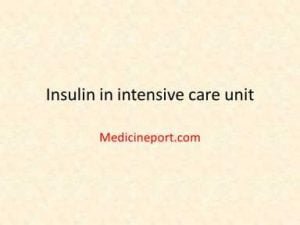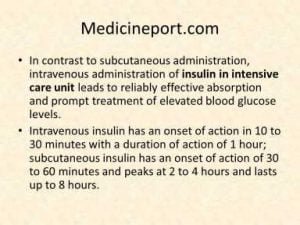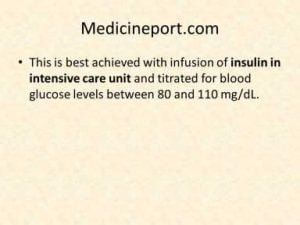 Regular insulin should be administered intravenously and not subcutaneously in the intensive care unit (ICU). This is because the rate of subcutaneous absorption of insulin in intensive care unit is highly variable.
Regular insulin should be administered intravenously and not subcutaneously in the intensive care unit (ICU). This is because the rate of subcutaneous absorption of insulin in intensive care unit is highly variable.
Insulin absorption is slower with high insulin concentrations and in the typically high dose volumes that are often required to control blood glucose in the critically ill.
In addition, decreased capillary surface area decreases absorption of insulin in intensive care unit ; because of poor perfusion, critically ill patients often experience this condition secondary to cardiogenic shock, hypotension, or vasopressor therapy.
 Lastly, poor perfusion of the subcutaneous tissues may lead to slow or erratic absorption of subcutaneous insulin in intensive care unit with resulting poor glucose control.
Lastly, poor perfusion of the subcutaneous tissues may lead to slow or erratic absorption of subcutaneous insulin in intensive care unit with resulting poor glucose control.
In contrast to subcutaneous administration, intravenous administration of insulin in intensive care unit leads to reliably effective absorption and prompt treatment of elevated blood glucose levels.
Intravenous insulin has an onset of action in 10 to 30 minutes with a duration of action of 1 hour; subcutaneous insulin has an onset of action of 30 to 60 minutes and peaks at 2 to 4 hours and lasts up to 8 hours.
 It cannot be overstated that strict glucose control reduces mortality. Intensive insulin therapy is recommended for critical care patients to maintain blood glucose between 80 and 110 mg/dL.
It cannot be overstated that strict glucose control reduces mortality. Intensive insulin therapy is recommended for critical care patients to maintain blood glucose between 80 and 110 mg/dL.
The risk reduction for mortality has been shown to be as high as 45%. Intensive insulin therapy reduces overall hospital mortality by 34%, bloodstream infections by 46%, acute renal failure requiring dialysis or hemofiltration by 41%, median number of red blood cell transfusions by 50%, and critical illness polyneuropathy by 44%.
This is best achieved with infusion of insulin in intensive care unit and titrated for blood glucose levels between 80 and 110 mg/dL.
For more info read the following:

Danke fur das info 🙂 heike (from germany)